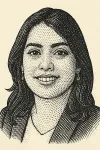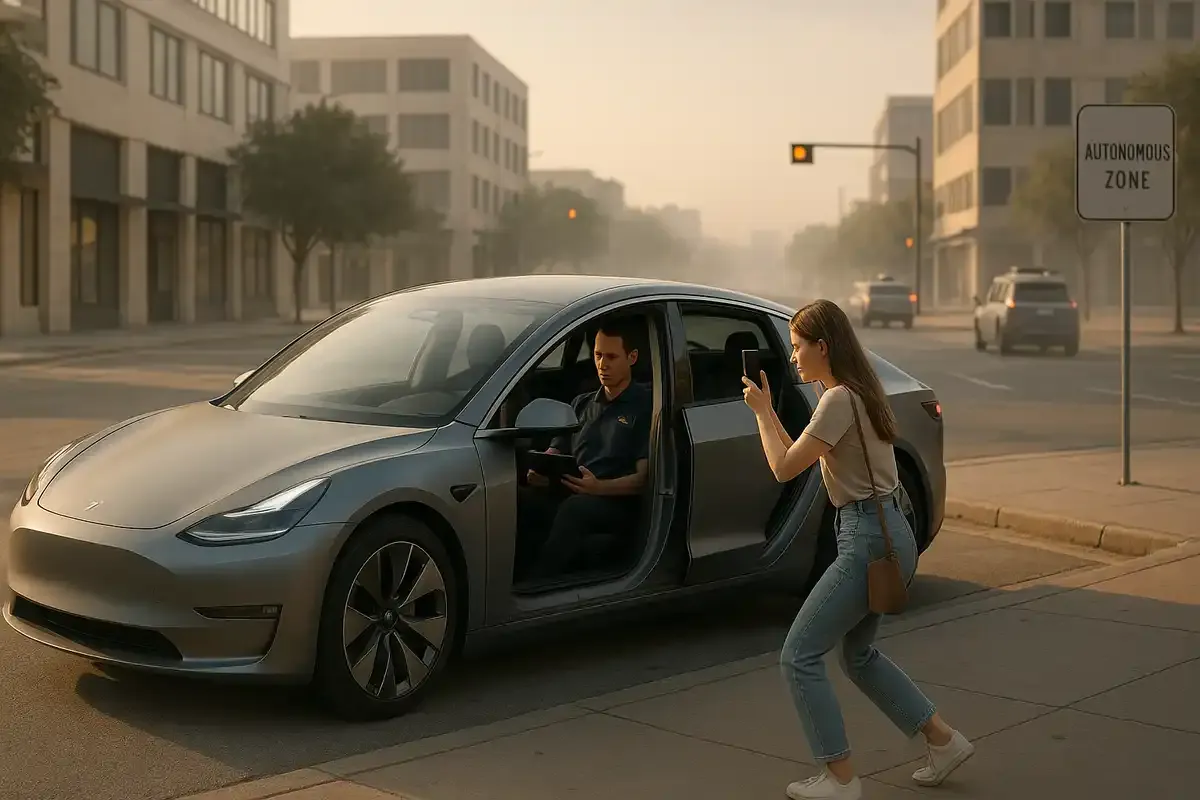💡 TL;DR - The 30 Seconds Version
🚗 Tesla launched robotaxis in Austin on Sunday with about 10 vehicles, but each car still carries a Tesla employee as a "safety monitor."
📱 The service costs $4.20 per ride and operates only for invited influencers in a small mapped area from 6 AM to midnight.
📊 Tesla lags far behind Waymo, which runs 1,500+ truly driverless vehicles across four cities and provides 250,000+ weekly rides.
⚖️ The launch came just days before new Texas regulations requiring state permits for autonomous vehicles take effect September 1.
🎯 Tesla's careful, limited rollout reveals the gap between Musk's decade of self-driving promises and current technical reality.
💰 Tesla's stock has risen 50% since April partly on robotaxi hopes, making this launch critical for justifying the company's valuation.
Tesla finally launched its robotaxi service in Austin on Sunday after a decade of promises from Elon Musk. The rollout was small, careful, and came with a human sitting in every car.
About 10 Tesla Model Y vehicles started picking up passengers in a limited area of South Austin. Each ride costs $4.20 flat. Each car carries a Tesla employee in the passenger seat as a "safety monitor."
The launch marks Tesla's first commercial robotaxi service, but it looks nothing like the fully autonomous future Musk has long promised. The vehicles operate only between 6 AM and midnight, avoid bad weather and complex intersections, and stick to thoroughly mapped roads in a small zone bordered by the Colorado River and Highway 183.
The invite-only club
Tesla didn't open the service to regular customers. Instead, the company sent invitations to select social media influencers and Tesla supporters over the past week. Many of the first riders were known for posting pro-Tesla content online.
This selective approach suggests Tesla wants to control the narrative around its early service. The company has actively blocked public records requests about the robotaxi program from both TechCrunch and Reuters.
Videos from the first rides show mostly smooth experiences. Passengers order cars through a dedicated Tesla app, similar to Uber. The vehicles navigate turns, speed bumps, and pedestrians without major issues. Most riders described the experience as "normal" and "smooth."
Not quite hands-off
The safety monitors sit in the passenger seat rather than behind the wheel. This creates the visual impression of a driverless car while keeping human oversight. Videos show these monitors gripping the door handle and keeping their thumb near what appears to be an emergency stop button.
Unlike competitors like Waymo, which removed human supervisors after extensive testing, Tesla is using safety monitors during commercial operations. Other companies typically use safety drivers only during testing phases.
At least one rider reported needing help from Tesla's remote support team during their trip, though details weren't shared. The company operates a control room with monitors showing live feeds from multiple vehicles.
Technical challenges surface
Early footage revealed some concerning behavior. One Tesla robotaxi was filmed hitting its brakes twice while passing parked police cars at a crime scene. The vehicle stopped in the middle of an intersection for no clear reason.
Tesla relies solely on cameras for navigation, unlike Waymo and other competitors that use radar and lidar sensors. Musk claims this camera-only approach will allow faster expansion at lower costs. Critics argue it's insufficient for safe autonomous driving.
The vehicles run on what Tesla calls an "unsupervised" version of its Full Self-Driving software, different from what regular Tesla owners can buy. However, the presence of safety monitors suggests the software isn't truly unsupervised.
Regulatory timing
The launch came just days before new Texas regulations take effect. Governor Greg Abbott signed legislation on Friday requiring state permits for autonomous vehicles starting September 1. The timing appears deliberate, allowing Tesla to operate under current rules before stricter oversight begins.
Democratic lawmakers had urged Tesla to delay the launch until September. The new law gives state authorities power to revoke permits from operators deemed dangerous to public safety.
Texas previously prohibited cities from regulating self-driving cars. The new rules mark a shift toward more oversight, though they remain less stringent than California's requirements.
Playing catch-up
Tesla faces a massive gap compared to Waymo, which operates over 1,500 autonomous vehicles across San Francisco, Los Angeles, Phoenix, and Austin. Waymo provides more than 250,000 paid rides weekly and launched its first public driverless service in 2020.
Musk has promised to scale Tesla's service rapidly, claiming there could be 1,000 robotaxis on the road "in a few months." He also wants to expand to San Francisco and Los Angeles. Industry experts say such rapid expansion is unlikely given the technical and regulatory challenges.
The commercial robotaxi business has proven difficult for everyone. GM's Cruise shut down after a serious accident. Amazon's Zoox and other competitors continue testing but haven't achieved large-scale deployment.
The billion-dollar bet
Tesla's stock has risen 50% since April partly on robotaxi hopes. The company's sky-high valuation depends heavily on Musk's promise to turn every Tesla into a money-making taxi when owners aren't using it.
The Austin launch uses standard Model Y vehicles, not the futuristic Cybercab revealed last year. Those vehicles, which lack steering wheels and pedals, won't arrive until 2026 at earliest and are promised to cost under $30,000.
Current Tesla owners can't yet monetize their cars through the robotaxi network. That capability remains a future promise, like many aspects of Musk's autonomous driving vision.
Why this matters:
- Tesla's cautious launch with human monitors reveals the gap between Musk's promises and current reality – true self-driving remains elusive even for the industry's biggest name.
- The company's invite-only approach and information suppression suggest it knows the technology isn't ready for broad public scrutiny, making this more marketing stunt than commercial breakthrough.
❓ Frequently Asked Questions
Q: Why does Tesla put the safety monitor in the passenger seat instead of behind the wheel?
A: Tesla wants to create the visual impression of a truly driverless car. Putting someone behind the wheel would make it obvious the car still needs human supervision. Other companies typically put safety monitors in the driver's seat during testing, but Tesla is using them during commercial service.
Q: How big is Tesla's operating area compared to Waymo?
A: Tesla operates in a small section of South Austin bounded by the Colorado River, Highway 183, and Zilker Park. Waymo runs 1,500+ vehicles across four entire cities (San Francisco, Los Angeles, Phoenix, Austin) and provides over 250,000 paid rides weekly versus Tesla's handful of invited rides.
Q: What happens when someone presses the support button during a ride?
A: Riders get placed in a queue to connect with Tesla's remote operators. During one test, it took about 2 minutes before an operator connected via cellular. Tesla runs a control room with large monitors showing live camera feeds from multiple vehicles.
Q: Why did Tesla launch right before new Texas regulations take effect?
A: Texas Governor Greg Abbott signed new autonomous vehicle rules on Friday that require state permits starting September 1, 2025. Tesla launched Sunday, getting three months to operate under current looser rules before stricter oversight begins.
Q: Can Tesla owners make money by turning their cars into robotaxis?
A: Not yet. Tesla's current service uses only company-owned Model Y vehicles with special software. Musk has promised to let owners monetize their personal Teslas through the robotaxi network, but that remains a future capability without a timeline.
Q: What's the deal with the $4.20 price?
A: The $4.20 flat fee is likely another of Musk's marijuana references. He previously got in trouble with the SEC for tweeting about taking Tesla private at $420 per share, calling it a weed joke during his deposition.
Q: How does Tesla's camera-only approach compare to competitors?
A: Tesla uses only cameras while Waymo and other competitors add radar and lidar sensors. Musk claims cameras will allow faster, cheaper expansion. Critics argue camera-only systems can't match the safety and reliability of multi-sensor approaches, especially in challenging conditions.
Q: When will Tesla use the Cybercab vehicles shown last year?
A: The futuristic Cybercabs with no steering wheel or pedals won't arrive until 2026 at earliest. Tesla promises they'll cost under $30,000. Current robotaxis use standard 2025 Model Y vehicles with modified software.
Q: What restrictions does Tesla's service have that Waymo doesn't?
A: Tesla avoids bad weather, complex intersections, highways, and airports. It only operates 6 AM to midnight in a small mapped area. Waymo operates 24/7 across entire cities, handles all weather conditions, and serves airports and highways.








